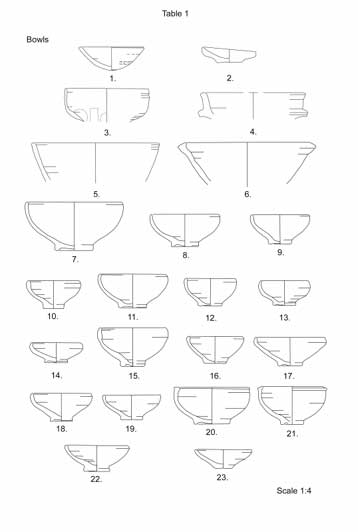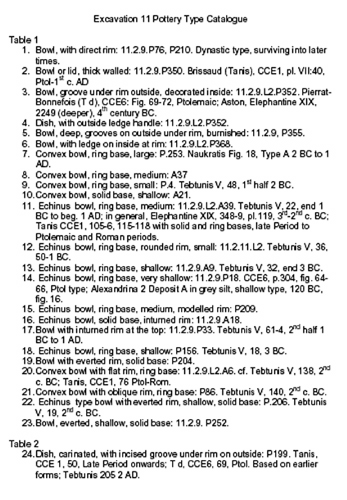Saïs Report, 2011
Season Reports
Saïs Report, 2011
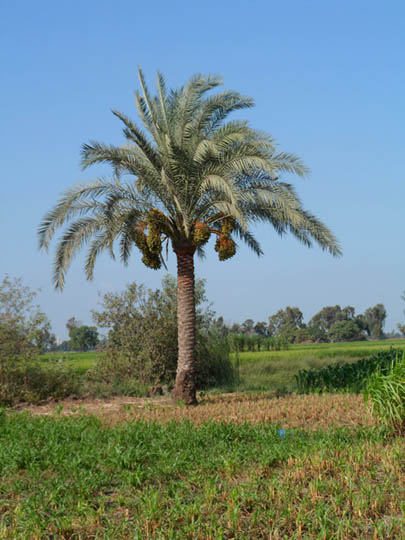
Date palm tree at Sa el-HagarIntroduction
The work this year comprised post-excavation study of material from previous excavations in order to continue to prepare it for publication. The study and recording of pottery collected by the Supreme Council of Antiquities from the waste water project in Sa el-Hagar was completed in order to analyse it for publication. As part of the ongoing commitment to publication of the work at Sais, the volume Sais I: The Ramesside-Third Intermediate Period at Kom Rebwa was published by the Egypt Exploration Society in October of this year.
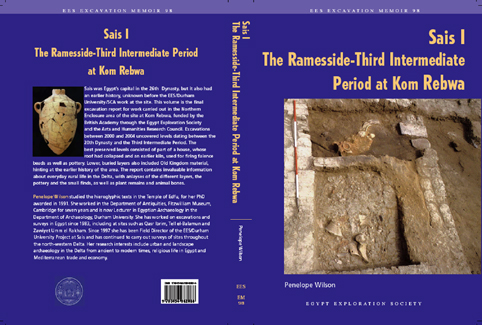
The Sais I volume.
Following the events of the 25th January Revolution, the area at Sa el Hagar had only suffered minor disturbances in the main archaeological areas, although there had been continued digging underneath private houses. The EES/Durham University magazine was found to be intact and undamaged. At Kom Rebwa, there were signs of recent digging in 5 places near to the area of our old Excavation 1, but it was not clear precisely when they had happened. The areas involved were relatively small and most of the earth removed was left at the site of the digging. During our stay at Sa el Hagar we mounted a display of information about our work at the magazine in order to inform the local community about the history and archaeology of Sais.
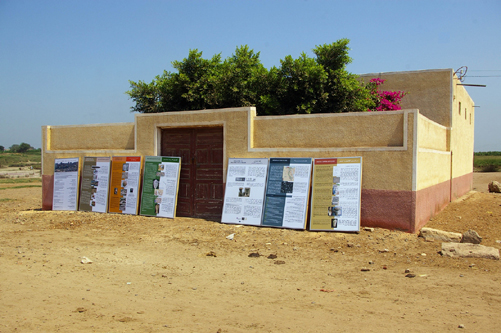
Display at the magazine.
Work was carried out in three stages: a week in April by Penny Wilson, three weeks in July by Penny Wilson, Sam Wilford (Durham University) and Ines Heide (Berlin Freie Universität) and then for four weeks in September by a team from Durham University including Sophia Carosi, Edward Caswell, Natalie Johnston, Tim Selby, Abigail Taylor, Jenny Thomas, Abigail Thompson and Rebecca Wells and the ceramic experts Aude Simony and Mikaël Pesenti. Egyptian Inspectors who received basic training included Khaled abeid el Shahat and Alaa Said Zailouk, while Ahmed Fahmy capably oversaw the work for the whole year and we are very grateful to him. Funding for the work came from a British Academy Small Research Grant, the North East Ancient Egypt Society (paying for Sam Wilford and Ines Heide’s participation), Durham University and individual contributions from societies.
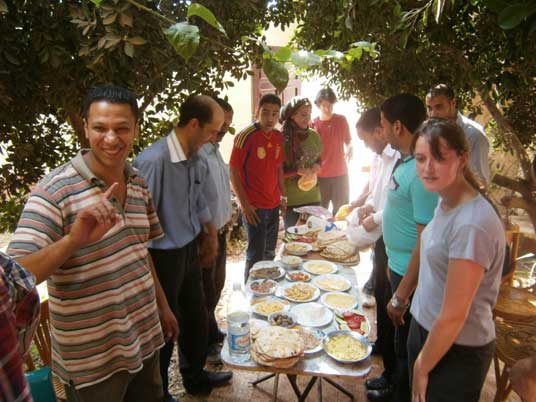
Breakfast with Sa el Hagar Inspectors (photograph by Abigail Taylor)
Work Undertaken in 2011 at Sais
1. Post-Excavation
Work continued on the material in the magazine in order to prepare some of it for publication. The 700 drawings of the pottery from the Prehistoric Period excavations were checked and corrected, if necessary, and photographs of relevant pieces were taken. The corrections were usually due to identification of parallels from other sites, so that stances could be changed, thus affecting the classification of some of the diagnostic sherds. The problem with some of the Prehistoric material was that the fragments of pottery were very small and so it was difficult to decide whether the some rims were open or closed, for example. A simple test was devised where the sherd was laid down flat on a piece of paper and then the rim was traced with a pencil. When the sherd was removed the resultant shape of the rim on the paper was used to suggest whether the vessel form was open or closed. A convex shaped represented a bowl, while a concave rim represented a closed form. In the case of line shapes which were more or less flat, then the test was unable to determine the type of vessel. The test did help to resolve most of the disputes over type, leaving only a few cases where exact identification of form was difficult. mainly due to the small size of the preserved sherd.
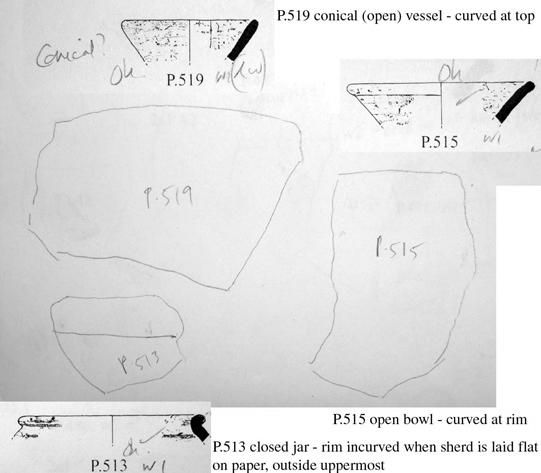
2. Excavation 11 Pottery
Work was continued to record and analyse the pottery collected from Excavation 11 in 2010. This excavation was carried out in 2010 on the western edge of the Great Pit close to the houses built there. It was not possible to carry out further work due to the post-revolution conditions and because the area of our work had been turned over to a more commercial use.
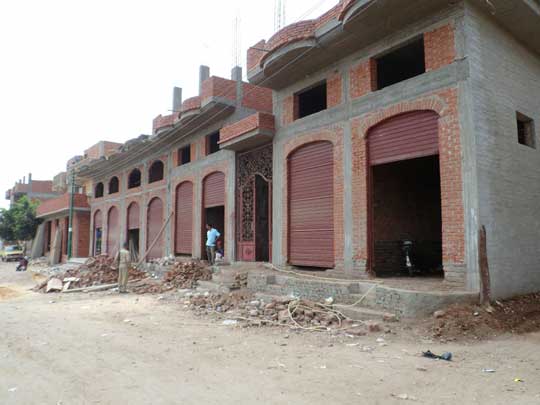
Shop front built directly next to Excavation 11.
The material we had excavated in 2010 comprised part of a rubbish dump of material dating to the end of the Ptolemaic and Imperial Roman period, with some intrusive earlier pottery from Dynasty 26-27. The typology and fabric study was refined and augmented by new types so that by the end of the work, the typology and frequency of types was completed by Aude Simony and Mikaël Pesenti. The material was drawn and photographed and its study provides information both about the industrial urban areas of Sais in the Late Period to the early Roman period, but also about the types of finewares and tablewares that were in demand in the town and the immediate area. .
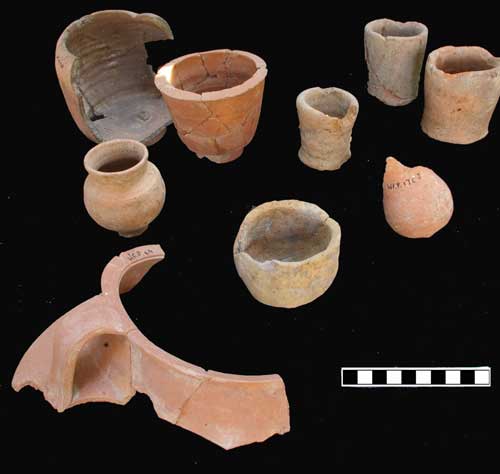
Group of vessels typical of the pottery dump.
Top left to right: ‘square’ casserole, ‘tulip’ bowl, 3 bread moulds; centre: ointment jar, ovoid jar, flask; bottom left: large cooking pot.
The collection also included some of the black gloss finewares which are said to have been manufactured in Buto. Further work may establish whether such material was produced only in Buto and sold outside the city or whether other places also produced the pottery, although perhaps to a lesser standard. A fancy lagynos (jug with one handle and wide body) recovered from near Excavation 11 suggested that typical hellenistic types were imitated in the local fabrics. The Egyptian imitations do not seem to have been as robust as their prototypes and this kind of experimentation may have been quite restricted in time.
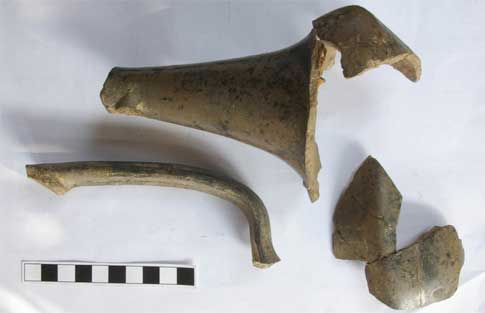
Lagynos fragments (above) and (below) reconstructed through the drawing by M. Pesenti.
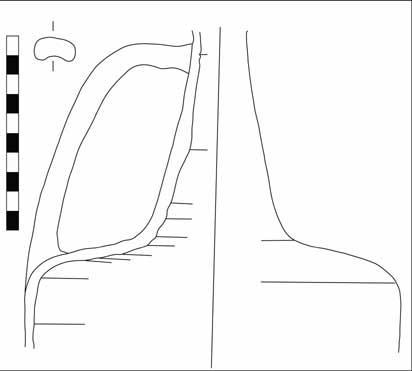
The preliminary study of the material also suggested that the Ptolemaic-Imperial Roman strata lay directly upon Dynasty 26 walls and material, with very little sign of Late Dynastic to early Ptolemaic material. This may suggest that the city was partially abandoned, at least on the western side after the end of the Saite dynasty and that it was only reoccupied in the Late Ptolemaic period. There seems to have been a ‘boom’ in the expansion of the city from this time and the early Roman town may have been rejuvenated perhaps as part of the programme of land exploitation in the Roman Empire. It is also clear that during the Ptolemaic and Roman periods the Pharaonic stone monuments were dismantled and pulverized, to provide raw stone building materials.
The renewal of the Saite population is exemplified by the pottery from Excavation 11, with its tablewares for domestic consumption, suggesting a growing local market and rapid production of pottery to a reasonable level of quality. The wasters amongst the pottery suggest that there was a kiln near the site of Excavation 11 and that the material was produced in the city itself.
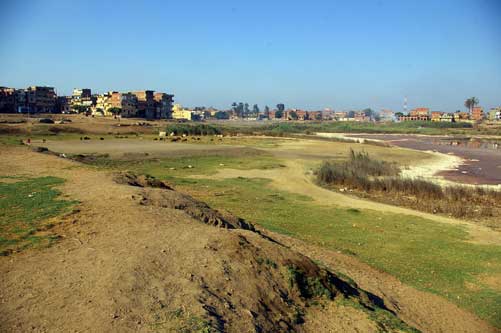
View towards the south-west of Sa el Hagar, with the modern village and Pit covering the Saite areas of the ancient town.
Typology from Excavation 11
The typology of pottery devised for Excavation 11 was refined and augmented following the study of the material by Aude Simony and Mikaël Pesenti. The drawings were digitised by Sofia Carosi and Penny Wilson.
Excavation 11 : Types of vessel.
Click image (left) to view full typology.(Requires PDF Viewer browser plug-in.)
Catalogue description to accompany types.
Click image (left) to view type catalogue.(Requires PDF Viewer browser plug-in.)
Several main types of form were recognised:
Bowls
i) Echinus bowl (bowl with in-curved rim and either a ring base or solid base);
ii) Bowl with grooved rim, with solid foot or ring base;
iii) Bowl with triangular section rim and ring base;
iv) Miscellaneous bowls with direct, straight rims, flat or rounded bases; plates; shallow bowls and lamps.
Ovoid Jars
i) With rounded or pointed bases, everted or straight necks
Jugs
i) With globular or more slender bodies and one handle, often coated with white or cream slip
Amphora types
i) Miniature amphorae imitating larger forms, with two handles.
Cooking pots
i) Straight sided, with slightly in-curved rim, often burnt on the outside;
ii) Larger, ledged rim pots, made of micaceous sandy fabric, with two handles;
iii) Triangular rim jars with horizontal handles.
Unguentaria, perfume or ‘spindle bottles’
i) Bottles with long, thin necks; ovoid bodies and long thin bases;
ii) Globular, squat jars with small handle, ‘Mendesian’ perfume type;
ii) Perfume bottles with squat globular bodies.
Miscellaneous jars
i) Large, wide bodies, relatively long necked jars, with ring bases (hydriae);
ii) Storage jars and transport amphorae
iii) Plates
Fabrics
Up to 18 fabric groups were identified, most of them Nile silt variants. The main difference between them was in the relative amounts of sand, chaff and limestone inclusions, which gave different properties to the fabric, as well as in the density of the fabric. Fabric XVII was recognised as the same as the Buto ‘black gloss’ pottery, with no added inclusions except for a small amount of chaff.
Dating
The date of the pottery was confirmed as mostly being from the late Ptolemaic to Early Roman period, with some residual examples of pottery from the Late Dynastic, specifically the late Saite-Persian period. This seems to imply that the area investigated in Excavation 11 had previously been in use from the Saite period, but had been reused at sometime from the 1st century BC to 3rd century AD as an industrial zone of some kind, perhaps for the manufacture of local pottery to serve the town of Sais. A number of wasters were found amongst the material, suggesting that some kind of manufacturing area was close by.
The amphorae from the pottery dump seemed to consist of Egyptian types, including AE2 and AE3 amphorae, dating from the Ptolemaic to Roman period, as well as imported amphorae including Cnidian types, Lesbian amphorae rims (residual), Rhodian mushroom amphorae rims. There was also one Egyptian imitation of a Mendesian amphora from Excavation 11.
Functions of the Pottery
The pottery consisted mostly of ‘fine’ tablewares for use in domestic contexts in the serving of food as well as cooking pots for use in the processing and preparation of food. The perfume jars also attest to the demand for scent in antiquity and seem to be an important part of the pottery repertoire. The amphorae from the group may also be connected with domestic functions, although the fact that they came to be discarded in the waste material from a kiln site may suggest that they were being used to carry water, or slip for use in the production of the finewares.
Some mould-made objects were also found, probably parts of terracotta lamps, including one decorated with a scarab, another with a sun-disk and another with palm fronds. This may suggest that some other types of terracotta object were being made in the kiln, such as lamps and mould-made figures. The find of black-gloss ware either suggests that it was imported from Buto, a main production centre, or that it was also being made elsewhere in places such as Sais.
Pottery and Stone from the Waste-Water Project in Sa el-Hagar
The recording of the material collected from the water project was completed. Altogether 150 units of pottery, faience and stone finds have been processed from the waste water project, specifically material which was collected in the line of the water trenches from the Abattoir to the north of Sais down the western side of the Great Pit and to the deep trench at Sidi Shadad. Approximately 15,000 sherds were individually recorded and around 4000 sherds or stone fragments were drawn. Diagnostic sherds such as rims, bases, handles and decorated body sherds were retained for future study.
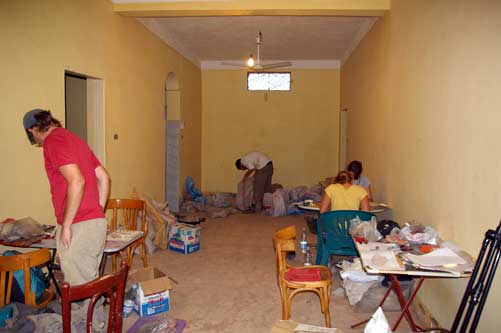
Working on the bags of sherds.
As noted previously, the material could be divided into relatively distinct sets:
i) Saite period material including archaic Greek amphorae and finewares as well as Cypriot pottery including ‘basket-handled’ jars, red polished Saite pottery, Dynasty 26 Nile silt pottery and Levantine ‘torpedo jars’, mortaria in all kinds of wares from the Late Dynastic through to the Roman period. A Clazomenian dipinti (painted pot-mark) was also recorded from the units studied this summer.
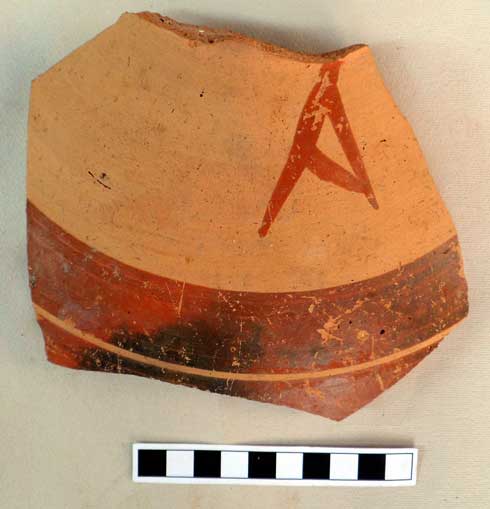
Dipinti from a Clazomenian amphora.
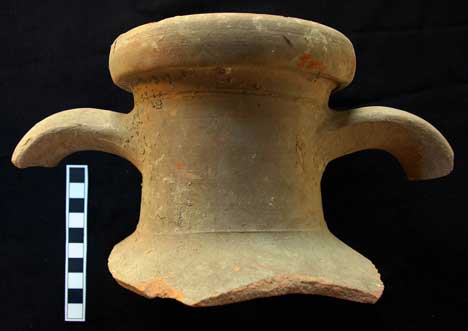
Samian amphora rim, neck and handle.
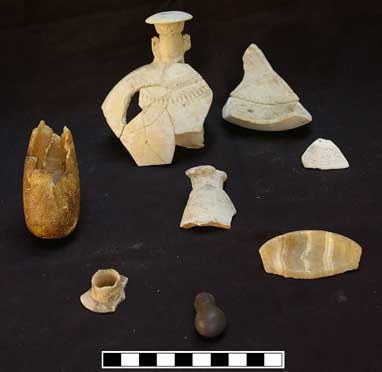
Saite material, including a faience pilgrim flask and small stone vessels.
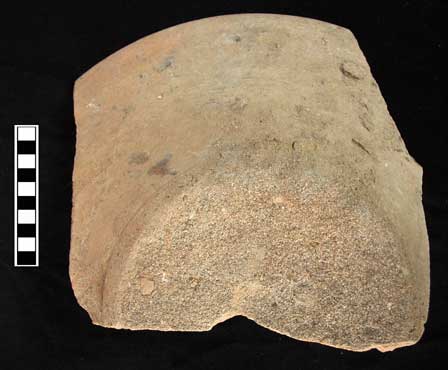
Mortarium with rough grit base.
ii) Ptolemaic to early Roman period material, specifically the pottery dump studied more thoroughly in Excavation 11, Roman amphorae dating from the 1st century BC through to the 3rd century AD, finewares and storage jars from the same period, as well as some stamped amphorae handles, including a rare example of an Egyptian stamp in the form of an ankh-sign.
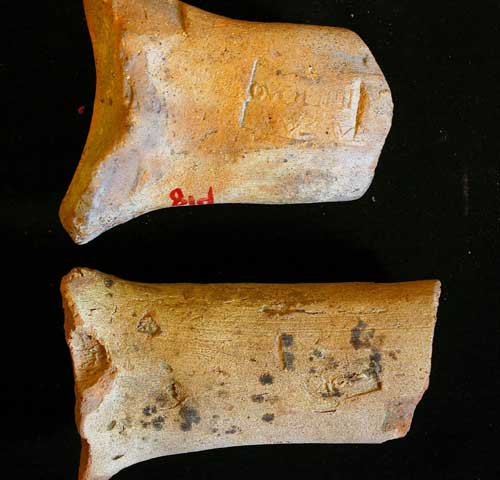
Stamped handles
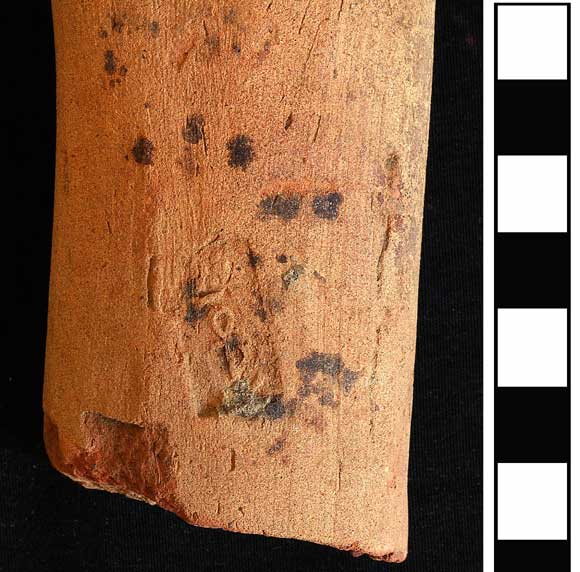
Detail of ankh-stamp on an amphora handle.
iii) Late Antique (Coptic) period, 4th to 7th century AD. A few examples of cooking jars and painted material from this period were identified, attesting to the lessening in use of this area and, perhaps, the shrinking in size of the town of Sais back to the old part of the city.
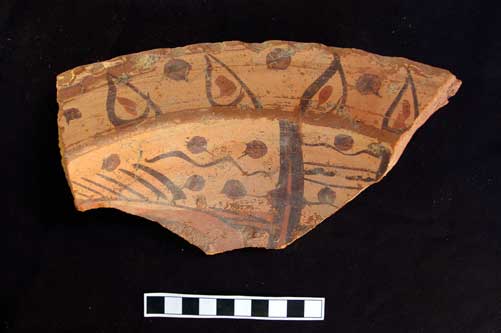
Painted decoration on the inside of large open jar.
iii) Islamic period to the modern era, including filter jugs, glazed fabrics and china ceramics. This material is most likely to be intrusive modern debris and attests to the partial use of the area into the modern period, with subsequent observation of the spread of the town back onto the western side of the Great Pit.
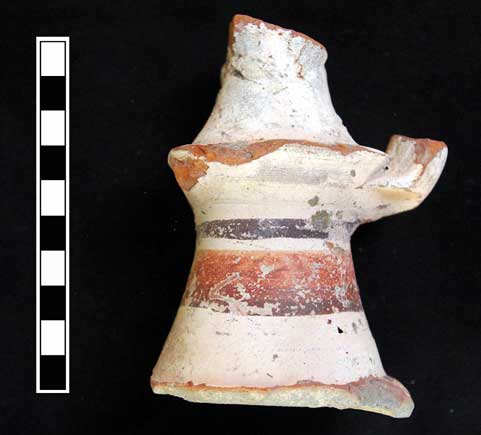
Fragment of a neck of a water jug, perhaps from the 9th century onwards.
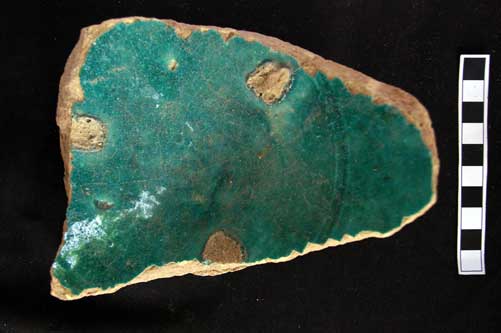
Glazed bowl, with marks where vessels were stacked on top of this bowl in the kiln, when fired.
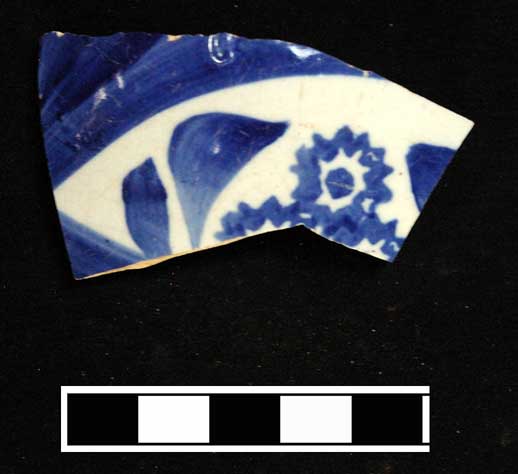
Modern blue and white porcelain.
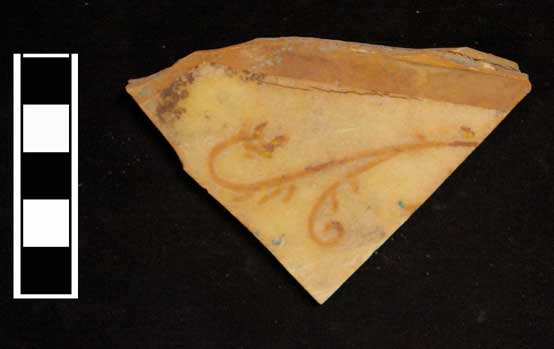
This delicate detail comes from a fragment of a plastic kitchen fitting.
The information from the material is invaluable for understanding the development of the ancient urban area of Sais during the Saite, Ptolemaic and Roman periods. It seems that the area on the western side of the Great Pit was an industrial zone during the Saite period and the area extended under the current town of Sa el Hagar in the central and western side of the old town. Ptolemaic and Roman industrial development continued on the western side, but also extended to the eastern side of the old town of Sa el Hagar, perhaps reflecting the expansion of the city. The Northern Enclosure area may have been abandoned from the end of the Dynastic Period, with the focal area for the settlement becoming the Saite town site, which is now the tell underneath Sa el Hagar.
The recorded information will now be processed in order to determine the exact dates of the underlying layers in different parts of the town and to find comparanda for rarer examples of amphorae and imported pottery in order to enhance our understanding of the trade links operating in the Late Dynastic-Roman period.
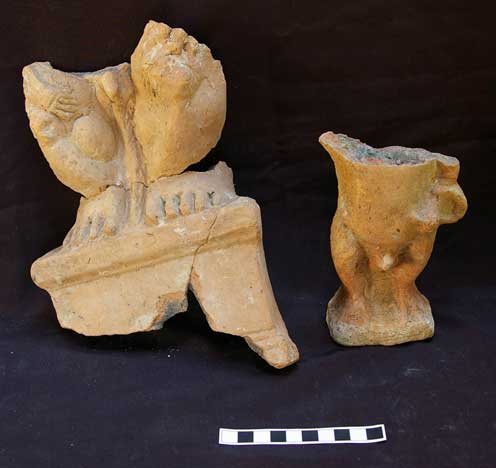
Warrior Bes figures from the Water Project.
Favourite Pieces
The Elephant Bowl: a bowl made from local fabric, with thick, polished red slip. Around the rim of the bowl were spouts in the form of elephant heads. They had large square ears with the wrinkles characteristic of elephant skin and may have originally each had a trunk through which water could be poured. Bowls with lion had spouts have been previously noted, but so far, this elephant bowl seems to be unique. Any readers of this web page with suggestions or parallels are most welcome to contact me (links at the end).
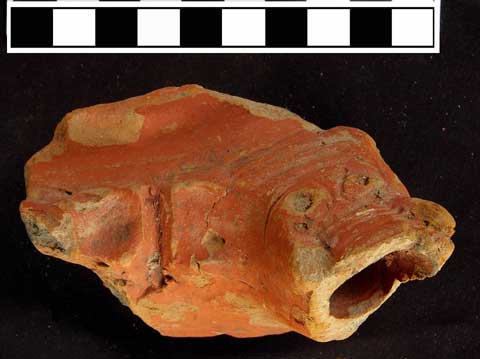
Above and below : Elephant bowl
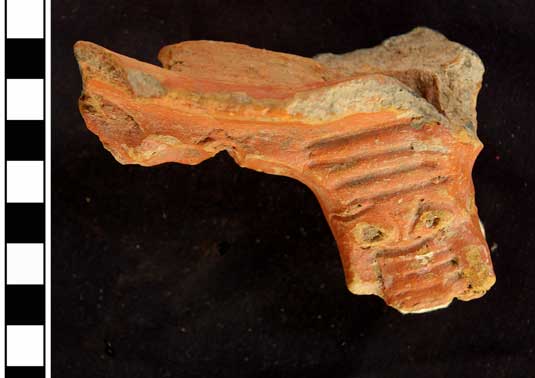
Pottery from Excavation 7 (2005)
The drawing and recording of this material was completed and confirmed as belonging, except for some intrusive Roman material, almost entirely to the Saite period, perhaps slightly earlier than the material from Excavation 4. This confirms the presence of Saite structures in the Northern Enclosure and the Roman material may suggest the date at which the buildings here were dismantled.
Pottery from the Area survey collected in 2010.
Material collected from the area survey from Kom Surad, Shabas Umayyir and Shuhada, Birma, Kom Abbud and Kom el Najjar was recorded and drawn. It was noticeable that most of the pottery dated to the Late Antique-Islamic period, some of possibly even into the Medieval period. Very little material was noted that seemed to date to earlier times. It had been expected that some evidence of satellite settlements to Sais would be located, but in fact the opposite seems to have been the case, with towns and villages appearing to have their heyday after the dissipation of the power of Sais. It may be that the individual agricultural land plots were divided out to small villages around Sais which then increased in size and prosperity at the expense of the ancient capital at Sais.
Pottery from the section cut in 2007.
A section was cut into the pottery mound which once lay over the limestone wall excavated by the SCA. This pottery was studied in order to give an idea about the date by which the limestone wall had been dismantled and the possible end of the temples in Sais. The main group of material dated to the end of the Ptolemaic and early Roman periods, similar in fact to the pottery from Excavation 11. A number of Italian imported finewares were noted, including some Barbotine wares. The most common type of amphora in the Great Pit section material was the AE3: 6.3 type (according to Dixneuf) which dates to the 2nd-3rd century AD and may be the actual date of the pottery dump over the stone wall. This would imply that by the third century at the latest the wall had been dismantled and the pottery refuse was encroaching upon it. Some earlier material from the Saite and Ptolemaic period was also found and is most likely to be residual, including examples of the red-slipped and polished lamps. There were also some local imitations of Cypriot sigillata, including collared bowls from the 1st century AD (thanks to Amir for this information).
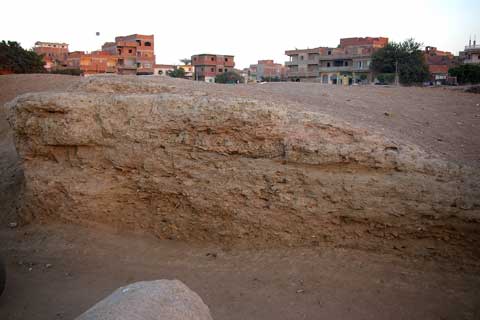
Section of pottery dump lying over the limestone temple wall fragment.
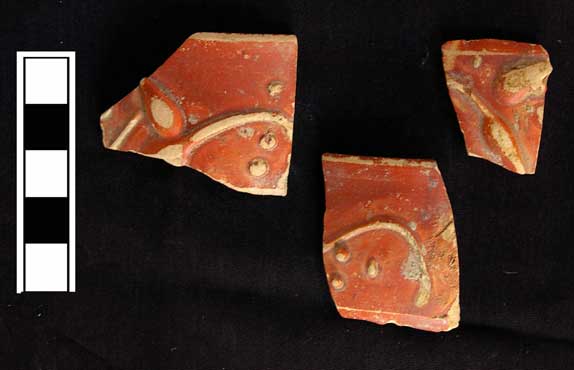
Barbotine/Aswan types of fineware fragments.
Summary
The aim of the work during the last three years was to collect information about the changes in the urban zones at Sais from the Saite period in the 7th century BC through to the final dissolution of the ancient capital and loss of power of Sais in the Roman period. It has been most helpful to be able to study a large group of material from a wide area of the site, that is the waste water project pottery, as well as specific samples of material from excavated contexts such as those from Excavation 11 and the section in the Great Pit. Together the general information from the wider picture, as well as the more controlled information from specific areas will give some idea about the types of activity taking place over a period of around 600 years at Sais. This information all assists in understanding the changes of the area at Sais from a major urban and political centre during the 26th Dynasty with trade links into the Aegean islands, Cyprus, the Levant and Italy to a smaller town dismantled for its stone, but still requiring local pottery for the inhabitants showing the integration of Sais into the wider Roman Empire and with trading links now very much internalised and perhaps also looking more to the west, with examples of Italian finewares and Tripolitanian amphorae from the pottery corpus. The wider picture from the area survey shows the completion of the removal of power from Sais and its dislocation to new centres in the area, which formed the centres for agricultural management and production.
Sais continues to provide a fascinating study in the rise and fall of a city in terms of its political and economic power, not just in Egypt but within the eastern Mediterranean world.
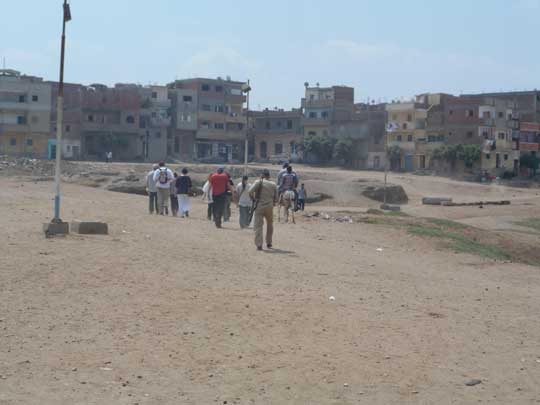
Going home at the end of work for the day.
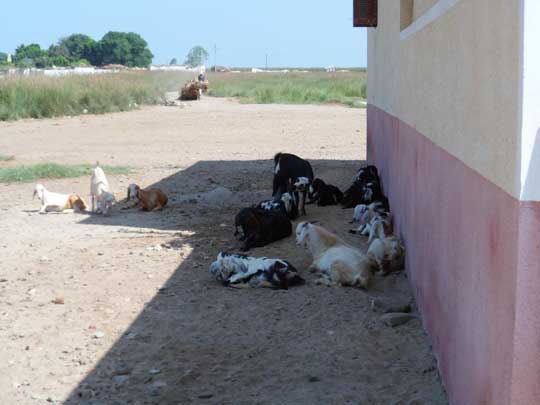
Goats colonising the shade created by the magazine.

